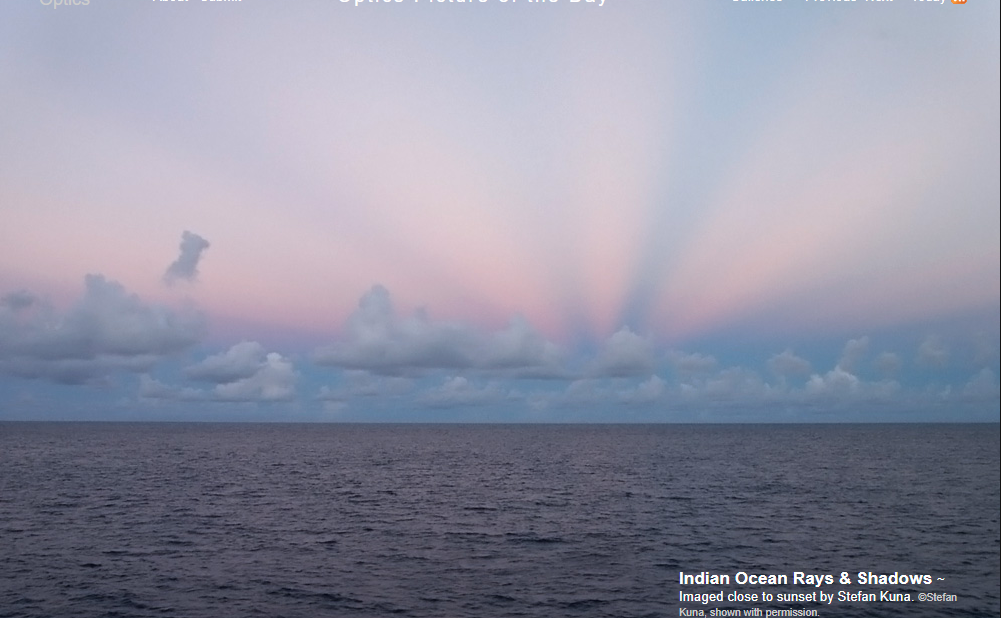OPOD - Earth & Cloud Shadows
OPOD - Earth & Cloud Shadows: A Fascinating Display of Atmospheric Optics
Atmospheric optics never ceases to amaze us with its mesmerizing displays. One such captivating phenomenon is the interplay of Earth and cloud shadows in the sky. As the sun sets on the horizon, it casts its last rays, which traverse a long path through the Earth's atmosphere. Along this journey, these rays interact with air molecules and small dust particles, causing preferential scattering of shorter wavelengths, such as blues. The result? The sky opposite the sunset is bathed in a soft rosy pink hue, a delightful spectacle for observers.
But it doesn't end there. The presence of clouds further enhances this atmospheric play. Beyond the field of view and even over the western horizon, clouds cast parallel shadows. However, due to the effect of perspective, these shadows appear to converge towards a specific point known as the antisolar point. This convergence creates a striking visual effect in the sky, capturing the imagination of anyone lucky enough to witness it.
The presence of these shadows provides intriguing insights into the position of the sun and the Earth's rotation. The alignment of the shadows reveals that the sun has already set at sea level, while the antisolar point hovers above the horizon. Beneath it, the dark blue shadow of the Earth itself slowly emerges, signifying its ascent.
To fully appreciate this atmospheric phenomenon, it is crucial to understand the underlying science. As sunlight interacts with Earth's atmosphere, it undergoes a process called Rayleigh scattering. This scattering occurs when light encounters molecules and small particles in the atmosphere, causing it to scatter in different directions. However, this scattering is not uniform across all wavelengths. Shorter wavelengths, such as blue and violet, are scattered more readily than longer wavelengths like red and orange.
The preferential scattering of shorter wavelengths by air molecules and dust particles creates a filtering effect on the sunlight. As a result, when the sun is low on the horizon during sunset, the remaining rays reaching our eyes are enriched with longer wavelengths, giving rise to the warm hues that paint the sky.
The convergence of cloud shadows towards the antisolar point is a result of perspective. Just as railroad tracks appear to converge in the distance, the parallel shadows cast by clouds also seem to meet at a single point due to our viewing position. This convergence creates an illusionary effect, captivating observers with its ethereal beauty.
It is important to note that this article has been automatically converted from the old site and may not appear as intended. However, the original article can be found on the Atmospheric Optics website for those interested in exploring this topic further.
In conclusion, the interplay of Earth and cloud shadows during sunset is a captivating display of atmospheric optics. From the soft pink hues of the sky opposite the sunset to the convergence of cloud shadows towards the antisolar point, this phenomenon never fails to inspire wonder. By understanding the science behind these effects, we can appreciate the intricate beauty of our atmosphere and its ability to create breathtaking displays for us to behold.

Indian Ocean Rays & Shadows ~ Imaged close to sunset by Stefan Kuna. ©Stefan Kuna, shown with permission.

The sky opposite the sunset is lit rosy pink. Low slanting rays from the last of the sun have coursed a long path through Earth�s atmosphere and been denuded of blues and other short wavelengths by air molecules and small dust preferentially scattering away that light.
Antisolar or anticrepuscular rays and shadows modulate the sky. The shadows from clouds out of the field of view or even beyond the western horizon are all parallel but appear by perspective to converge towards the antisolar point. The shadows show that the sun has already set at sea level and the antisolar point is above the horizon. Below it the dark blue shadow of the earth itself is rising.
Note: this article has been automatically converted from the old site and may not appear as intended. You can find the original article here.
Reference Atmospheric Optics
If you use any of the definitions, information, or data presented on Atmospheric Optics, please copy the link or reference below to properly credit us as the reference source. Thank you!
-
<a href="https://atoptics.co.uk/blog/opod-earth-cloud-shadows/">OPOD - Earth & Cloud Shadows</a>
-
"OPOD - Earth & Cloud Shadows". Atmospheric Optics. Accessed on November 26, 2024. https://atoptics.co.uk/blog/opod-earth-cloud-shadows/.
-
"OPOD - Earth & Cloud Shadows". Atmospheric Optics, https://atoptics.co.uk/blog/opod-earth-cloud-shadows/. Accessed 26 November, 2024
-
OPOD - Earth & Cloud Shadows. Atmospheric Optics. Retrieved from https://atoptics.co.uk/blog/opod-earth-cloud-shadows/.